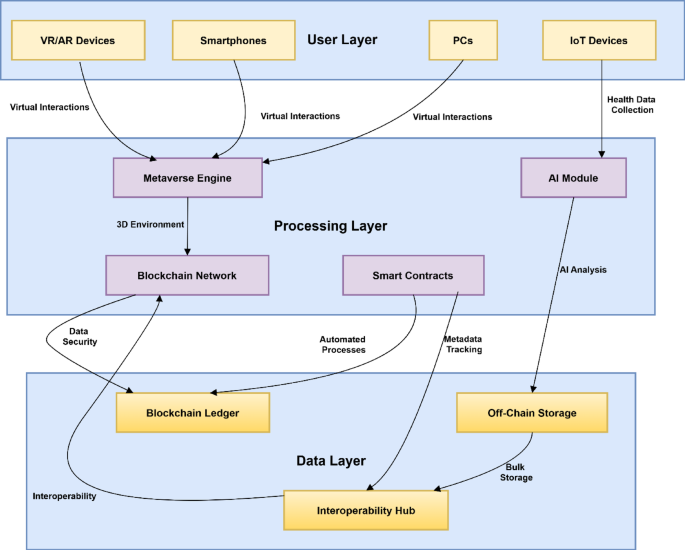Revolutionizing Telemedicine: Blockchain-Powered Metaverse for Scalable Care

Revolutionizing Telemedicine: The Integration of Blockchain and metaverse Technologies
Overview of the Proposed Telemedicine System
A groundbreaking telemedicine framework is emerging, leveraging Blockchain and metaverse technologies to enhance healthcare delivery. This innovative system combines Virtual Reality (VR), Augmented Reality (AR), Internet of Things (IoT), and Artificial Intelligence (AI) across a four-layer architecture: User Interaction, Data Processing, Blockchain, and Storage & Interoperability. This structure aims to improve patient engagement, safeguard medical information, enable seamless electronic health record (EHR) sharing, and automate various healthcare processes.
- Overview of the Proposed Telemedicine System
- System Configuration
- Utilizing metaverse and VR/AR for Consultations
- IoT-Driven Health Monitoring and AI Diagnostics
- Blockchain for Enhanced Security and Data Integrity
- Feasibility and Scalability Analysis
- Strategies for Latency Optimization
- Results of the System Evaluation
- User Engagement Metrics
- Data Security Assessment
- Efficiency Evaluation
- Scalability Testing
- Accessibility Analysis
- Comparative Evaluation with Existing Solutions
- Challenges in Real-World Implementation
System Configuration
Utilizing metaverse and VR/AR for Consultations
The User Interaction layer employs VR and AR to create immersive virtual environments where healthcare professionals can conduct live consultations with patients. Development of these 3D spaces is facilitated by platforms like Unity 3D and Unreal Engine, while the WebXR API ensures compatibility for users without specialized VR equipment. The Photon Engine supports real-time interactions, allowing multiple users to engage in consultations simultaneously.
Patient involvement is significantly enhanced through avatar-based interactions, enabling individuals to create digital representations of themselves. Gesture tracking technology, such as Leap Motion and Oculus Hand Tracking SDK, adds realism to virtual consultations. Security measures include AES-256 encryption for virtual interactions, with data securely stored in the InterPlanetary File System (IPFS).
For optimal performance, the VR telemedicine system requires low-latency interactions of less than 20 milliseconds and bandwidth ranging from 10 to 50 Mbps, depending on the complexity of the virtual environment. High-performance NVIDIA RTX series GPUs are recommended for efficient rendering of 3D models and avatars.
IoT-Driven Health Monitoring and AI Diagnostics
The Data Processing Layer integrates medical IoT devices and AI analytics to facilitate real-time patient monitoring and diagnostics. Devices such as medical-grade ECG monitors, Apple Watches, and Fitbits continuously track vital signs, including heart rate and blood pressure. The system employs MQTT protocol and Bluetooth Low Energy (BLE) for live data transmission.
Advanced algorithms, including Convolutional Neural Networks (CNNs) and Long Short-Term Memory (LSTM) networks, are utilized for anomaly detection in health data. This enables the system to provide immediate alerts for critical conditions, such as arrhythmias or significant drops in oxygen levels. The architecture supports over 10,000 connected IoT devices through Kubernetes-based auto-scaling, while edge computing devices like Raspberry Pi facilitate AI processing locally, reducing reliance on cloud connectivity.
Blockchain for Enhanced Security and Data Integrity
The Blockchain Layer ensures data integrity, security, and automation of healthcare processes. Built on Ethereum 2.0, the system utilizes a Proof of Stake (PoS) consensus mechanism to enhance scalability and reduce energy consumption. Smart contracts, developed in Solidity, manage essential healthcare functions such as patient consent, EHR access, and insurance claims.
Data privacy is maintained through SHA-256 hashing, which stores cryptographic hashes of EHRs on-chain while keeping the actual records off-chain in IPFS. Patients control access to their data via smart contracts, ensuring compliance with HIPAA and GDPR regulations.
Ethereum 2.0’s PoS model significantly lowers transaction costs compared to Proof of Work (PoW) systems, achieving over 10,000 transactions per second (TPS). This public blockchain framework allows for global participation in telemedicine networks, promoting transparency and decentralization.
Feasibility and Scalability Analysis
The proposed system effectively addresses common challenges in telemedicine, including scalability, security, and performance. Key factors influencing implementation include:
- Throughput: Capable of managing 10,000 active IoT data streams while executing blockchain transactions at over 10,000 TPS.
- Cost Efficiency: The PoS mechanism and partitioning of EHRs into on-chain and off-chain components significantly reduce costs.
- Regulatory Compliance: Blockchain audit trails and access controls ensure adherence to GDPR standards.
Strategies for Latency Optimization
Minimizing latency is crucial for seamless telemedicine experiences, especially with VR technology. The proposed framework achieves low latency through optimized front-end rendering and decentralized data management.
WebXR enables quick immersive consultations with minimal overhead, maintaining interaction latency below 50 milliseconds. Real-time data transmission from sensors and media streaming is facilitated by MQTT and WebRTC, both of which are efficient in low-bandwidth environments.
EHRs and diagnostic information are stored off-chain, with only their metadata and hash values on the blockchain, reducing congestion and enabling faster transaction completion. This design fosters a responsive telehealth experience, allowing for secure and efficient consultations.
Results of the System Evaluation
Performance metrics were gathered through controlled simulations, comparing the system against established benchmarks. WebXR tests consistently achieved latency under 50 milliseconds, meeting industry standards for VR consultations. Data retrieval from IPFS for 100 concurrent users averaged below 300 milliseconds, while smart contract transactions on the Ethereum Sepolia testnet averaged 0.45 seconds.
Scalability was assessed using Node.js, simulating up to 1,000 concurrent users. Metrics such as transaction latency, throughput, session success rates, and user satisfaction were recorded. Testing involved synthetic workloads across varying user counts and internet speeds.
User Engagement Metrics
User engagement is measured by the system’s ability to capture interest and ensure adherence to therapy plans. Metrics include visit frequency, duration, patient satisfaction, and retention rates. The system was evaluated through simulation sessions with varying user counts, collecting feedback on session duration and satisfaction.
Data Security Assessment
Data security was evaluated by monitoring unauthorized access attempts and breaches. The blockchain framework enhances security through encryption and immutable records. Penetration tests simulated unauthorized access attempts, demonstrating the system’s resilience against breaches.
Efficiency Evaluation
Efficiency was measured based on the time and accuracy of tasks such as consultations and data retrieval. The system’s performance was evaluated through transaction confirmation times and 3D environment rendering, revealing an inverse relationship between transaction volume and execution time.
Scalability Testing
Scalability was assessed by simulating varying numbers of concurrent users and transaction throughput. Tests demonstrated that as user numbers increased, system throughput decreased, highlighting the need for ongoing optimization.
Accessibility Analysis
Accessibility metrics evaluate how effectively the platform can be utilized, particularly in developing regions. Success rates were measured under low bandwidth conditions, revealing that increased bandwidth correlates with higher success rates in telemedicine sessions.
Comparative Evaluation with Existing Solutions
While blockchain technology has been explored in healthcare, the integration with the metaverse remains under-researched. This study compares the proposed system with three notable publications, highlighting the lack of empirical testing in existing models.
Challenges in Real-World Implementation
Despite the system’s technical capabilities, several challenges must be addressed for real-world deployment:
- Regulatory Compliance: Adhering to diverse regulations across countries poses significant challenges, particularly concerning immutable data storage.
- Infrastructure Disparities: Limited access to high-speed internet and compatible devices in rural areas hampers equitable telemedicine access.
- Legacy System Integration: Many healthcare facilities rely on outdated EHR systems, complicating interoperability.
- User Adaptation: Both patients and healthcare providers may require time to familiarize themselves with immersive technologies and blockchain tools.
This innovative telemedicine system represents a significant advancement in healthcare delivery, combining cutting-edge technologies to enhance patient care while addressing critical challenges in the industry.







